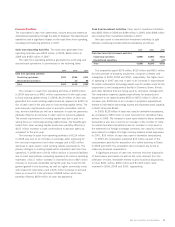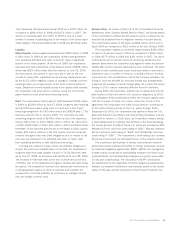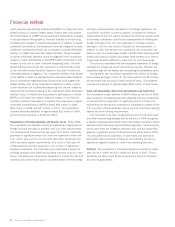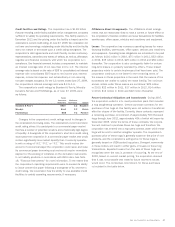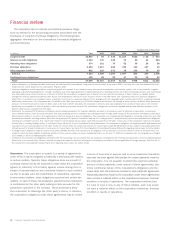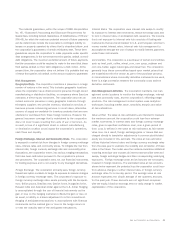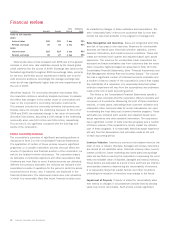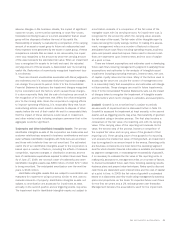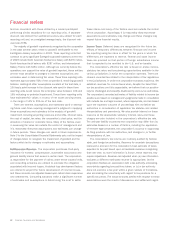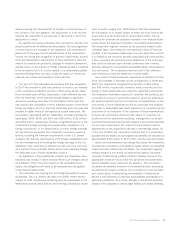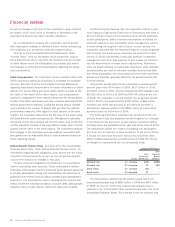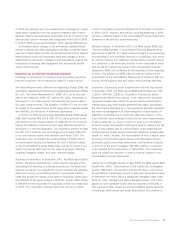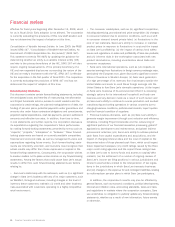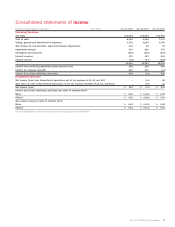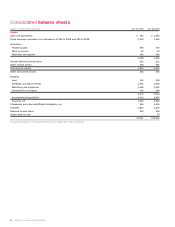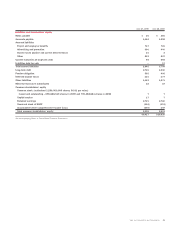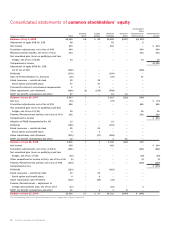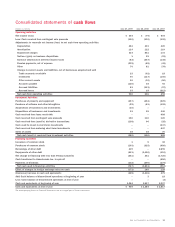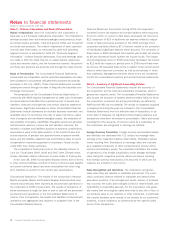Sara Lee 2009 Annual Report Download - page 44
Download and view the complete annual report
Please find page 44 of the 2009 Sara Lee annual report below. You can navigate through the pages in the report by either clicking on the pages listed below, or by using the keyword search tool below to find specific information within the annual report.Financial review
test are consistent with those utilized by a market participant
performing similar valuations for our reporting units. A separate
discount rate derived from published sources was utilized for each
reporting unit and, on a weighted average basis, the discount rate
used was 8.9%.
The majority of goodwill impairments recognized by the corporation
in the past several years relate to goodwill attributable to the
Earthgrains bakery acquisition in 2002. Three reporting units that
continue to carry significant Earthgrains goodwill balances at the end
of 2009 include North American foodservice bakery with $476 million,
North American fresh bakery with $287 million, and International
Bakery France with $181 million. Although we currently believe the
operations can support the value of goodwill reported, these entities
are the most sensitive to changes in inherent assumptions and
estimates used in determining fair value. These three reporting units
represent approximately 50% of the corporation’s remaining goodwill
balance. Holding all other assumptions constant at the test date, a
100 basis point increase in the discount rate used for these three
reporting units would reduce the enterprise value between 10% and
15% indicating no potential impairment. These three reporting units
have estimated fair values in excess of net asset carrying values
in the range of 15% to 25% as of the test date.
There are inherent assumptions and estimates used in develop-
ing future cash flows requiring management's judgment in applying
these assumptions and estimates to the analysis of goodwill
impairment including projecting revenues and profits, interest rates,
the cost of capital, tax rates, the corporation’s stock price, and the
allocation of shared or corporate items. Many of the factors used
in assessing fair value are outside the control of management and
it is reasonably likely that assumptions and estimates can change
in future periods. These changes can result in future impairments.
Note 3 to the Consolidated Financial Statements sets out the impact
of charges taken to recognize the impairment of goodwill and the
factors which led to changes in estimates and assumptions.
Self-Insurance Reserves The corporation purchases third-party
insurance for workers’ compensation, automobile and product and
general liability claims that exceed a certain level. The corporation
is responsible for the payment of claims under these insured limits,
and consulting actuaries are utilized to estimate the obligation
associated with incurred losses. Historical loss development factors
are utilized to project the future development of incurred losses,
and these amounts are adjusted based upon actual claim experience
and settlements. Consulting actuaries make a significant number
of estimates and assumptions in determining the cost to settle
these claims and many of the factors used are outside the control
of the corporation. Accordingly, it is reasonably likely that these
assumptions and estimates may change and these changes may
impact future financial results.
Income Taxes Deferred taxes are recognized for the future tax
effects of temporary differences between financial and income
tax reporting using tax rates in effect for the years in which the
differences are expected to reverse. Federal and state income
taxes are provided on that portion of foreign subsidiaries income
that is expected to be remitted to the U.S. and be taxable.
The corporation’s effective tax rate is based on pretax income,
statutory tax rates and tax planning opportunities available in the
various jurisdictions in which the corporation operates. There are
inherent uncertainties related to the interpretation of tax regulations
in the jurisdictions in which the corporation transacts business. We
establish reserves for income taxes when, despite the belief that
our tax positions are fully supportable, we believe that our position
may be challenged and possibly disallowed by various tax authorities.
The corporation’s recorded estimates of liability related to income tax
positions are based on management’s judgments made in consultation
with outside tax and legal counsel, where appropriate, and are based
upon the expected outcome of proceedings with worldwide tax
authorities in consideration of applicable tax statutes and related
interpretations and precedents. We also provide interest on these
reserves at the appropriate statutory interest rates and these
charges are also included in the corporation’s effective tax rate.
The ultimate liability incurred by the corporation may differ from its
estimates based on a number of factors, including the application
of relevant legal precedent, the corporation’s success in supporting
its filing positions with tax authorities, and changes to, or further
interpretations of, law.
The corporation’s tax returns are routinely audited by federal,
state, and foreign tax authorities. Reserves for uncertain tax positions
represent a provision for the corporation’s best estimate of taxes
expected to be paid based upon all available evidence recognizing
that over time, as more information is known, these reserves may
require adjustment. Reserves are adjusted when (a) new information
indicates a different estimated reserve is appropriate; (b) the
corporation finalizes an examination with a tax authority, eliminating
uncertainty regarding tax positions taken; or (c) a tax authority
does not examine a tax year within a given statute of limitations,
also eliminating the uncertainty with regard to tax positions for a
specific tax period. The actual amounts settled with respect to these
examinations were the result of discussions and settlement negoti-
42 Sara Lee Corporation and Subsidiaries



